Ectopic expression of LIM-nebulette (LASP2) reveals roles in cell migration and spreading
- PMID: 18677772
- PMCID: PMC2603443
- DOI: 10.1002/cm.20304
Ectopic expression of LIM-nebulette (LASP2) reveals roles in cell migration and spreading
Abstract
LIM-nebulette (LASP2) is a small focal adhesion protein and a member of the nebulin family of actin binding proteins. This recently identified splice variant of the nebulette locus is widely expressed and highly enriched in neuronal tissue. Other than that LIM-nebulette is a focal adhesion protein and interacts with zyxin, nothing is known about its function. Given that LIM-nebulette has an identical modular organization and overlapping tissue distributions to that of LASP1, we have analyzed the role of LIM-nebulette in comparison with that of LASP1. We find that LIM-nebulette is a dynamic focal adhesion protein that increases the rate of attachment and spreading of fibroblasts on fibronectin coated surfaces. Additionally, LIM-nebulette is recruited from the cortical cytoskeleton in non-motile cells to focal adhesions at the leading edge of stimulated cells. In confluent cultures of HeLa and NIH3T3 cells, LIM-nebulette co-localizes with alpha-catenin in putative adherens junctions, whereas LASP1 is devoid of these areas. Interestingly, overexpression of LIM-nebulette in PC6 cells inhibits neurite outgrowth in response to growth factors. Collectively, our data indicate that LIM-nebulette and LASP1 have distinct roles in the actin cytoskeleton.
Copyright 2008 Wiley-Liss, Inc.
Figures




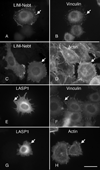
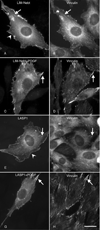


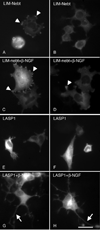
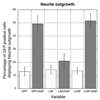
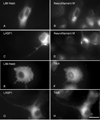
Similar articles
-
Zyxin interacts with the SH3 domains of the cytoskeletal proteins LIM-nebulette and Lasp-1.J Biol Chem. 2004 May 7;279(19):20401-10. doi: 10.1074/jbc.M310304200. Epub 2004 Mar 5. J Biol Chem. 2004. PMID: 15004028
-
Linker region of nebulin family members plays an important role in targeting these molecules to cellular structures.Cell Tissue Res. 2007 Feb;327(2):353-69. doi: 10.1007/s00441-006-0305-2. Epub 2006 Oct 3. Cell Tissue Res. 2007. PMID: 17177073
-
The Nebulin Family LIM and SH3 Proteins Regulate Postsynaptic Development and Function.J Neurosci. 2020 Jan 15;40(3):526-541. doi: 10.1523/JNEUROSCI.0334-19.2019. Epub 2019 Nov 21. J Neurosci. 2020. PMID: 31754010 Free PMC article.
-
Roles of Nebulin Family Members in the Heart.Circ J. 2015;79(10):2081-7. doi: 10.1253/circj.CJ-15-0854. Epub 2015 Aug 31. Circ J. 2015. PMID: 26321576 Review.
-
An update on the LIM and SH3 domain protein 1 (LASP1): a versatile structural, signaling, and biomarker protein.Oncotarget. 2015 Jan 1;6(1):26-42. doi: 10.18632/oncotarget.3083. Oncotarget. 2015. PMID: 25622104 Free PMC article. Review.
Cited by
-
α-catenin phosphorylation is elevated during mitosis to resist apical rounding and epithelial barrier leak.Biol Open. 2025 Jan 15;14(1):bio061726. doi: 10.1242/bio.061726. Epub 2025 Jan 8. Biol Open. 2025. PMID: 39782767 Free PMC article.
-
LIM-Nebulette Reinforces Podocyte Structural Integrity by Linking Actin and Vimentin Filaments.J Am Soc Nephrol. 2020 Oct;31(10):2372-2391. doi: 10.1681/ASN.2019121261. Epub 2020 Jul 31. J Am Soc Nephrol. 2020. PMID: 32737144 Free PMC article.
-
Estrogen induced breast cancer is the result in the disruption of the asymmetric cell division of the stem cell.Horm Mol Biol Clin Investig. 2010 Jan 1;1(2):53-65. doi: 10.1515/HMBCI.2010.011. Horm Mol Biol Clin Investig. 2010. PMID: 21258630 Free PMC article.
-
LASP2 suppresses colorectal cancer progression through JNK/p38 MAPK pathway meditated epithelial-mesenchymal transition.Cell Commun Signal. 2017 Jun 12;15(1):21. doi: 10.1186/s12964-017-0179-9. Cell Commun Signal. 2017. PMID: 28606091 Free PMC article.
-
The Nebulin family: an actin support group.Trends Cell Biol. 2011 Jan;21(1):29-37. doi: 10.1016/j.tcb.2010.09.005. Epub 2010 Oct 15. Trends Cell Biol. 2011. PMID: 20951588 Free PMC article. Review.
References
-
- Chew CS, Chen X, Parente JA, Jr, Tarrer S, Okamoto C, Qin HY. Lasp-1 binds to non-muscle F-actin in vitro and is localized within multiple sites of dynamic actin assembly in vivo. J Cell Sci. 2002;115:4787–4799. - PubMed
-
- Chew CS, Parente JA, Jr, Chen X, Chaponnier C, Cameron RS. The LIM and SH3 domain-containing protein, lasp-1, may link the cAMP signaling pathway with dynamic membrane restructuring activities in ion transporting epithelia. J Cell Sci. 2000;113:2035–2045. - PubMed
-
- Chew CS, Parente JA, Jr, Zhou C, Baranco E, Chen X. Lasp-1 is a regulated phosphoprotein within the cAMP signaling pathway in the gastric parietal cell. Am J Physiol. 1998;275:C56–C67. - PubMed
-
- Grunewald TG, Kammerer U, Schulze E, Schindler D, Honig A, Zimmer M, Butt E. Silencing of LASP-1 influences zyxin localization, inhibits proliferation and reduces migration in breast cancer cells. Exp Cell Res. 2006;312:974–982. - PubMed
-
- Katoh M. Identification and characterization of LASP2 gene in silico. Int J Mol Med. 2003;12:405–410. - PubMed
Publication types
MeSH terms
Substances
Grants and funding
LinkOut - more resources
Full Text Sources
Miscellaneous

